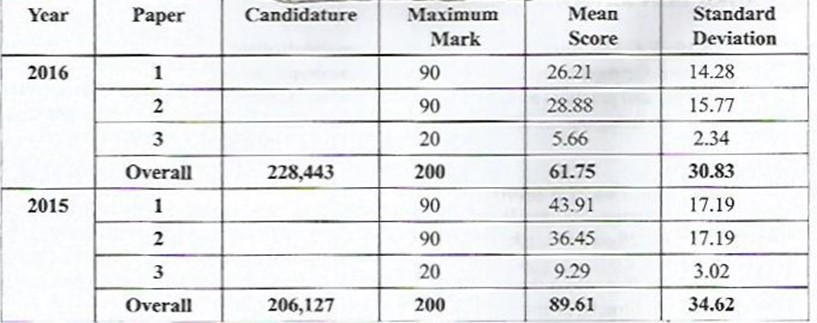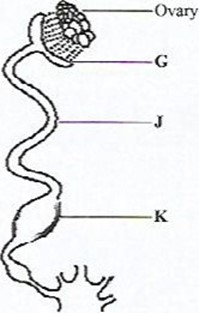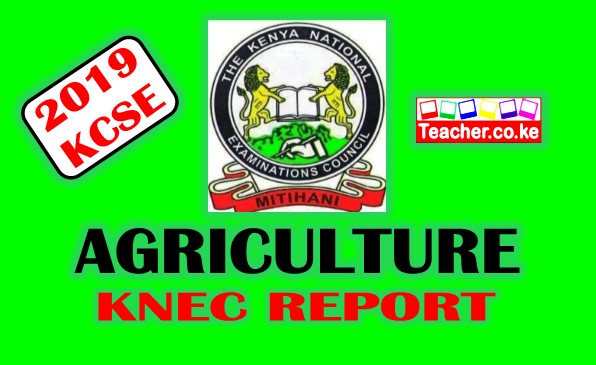In the year 2019, K.C.S.E Agriculture Examination consisted of three papers; Paper l, Paper 2, and Paper 3. The three papers tested the candidates’ competence in understanding the agricultural principles, concepts, and practices as stipulated in the syllabus. A wide range of knowledge and skills was tested in order to bring out the different abilities of the candidates. The format of the three papers is as follows:
-
Paper 1 (443/1): This is a theory paper that covers General Agriculture, Crop Production, Agriculture Economics, Soil and Water Conservation. It has three sections: A, B, and C, which are marked out of30, 20, and 40 marks respectively.
-
Paper 2 (443/2): It is also a theory paper but covers Livestock Production, Farm Power, Farm Machinery, Farm Structures, and Farm Tools and Equipment. It has three sections, A, B, and C, which are also marked out of30, 20, and 40 marks respectively.
-
Paper3 (443/3): This is a project paper with two project questions, Project A and B. In 2019, one of the projects required candidates to grow finger millet while the second one was on the rearing of Chicken. Candidates selected and carried out only one of the two projects. The project paper is scored out of 100 marks-
3.8-1 CANDIDATES’ OVERALL PERFORMANCE IN AGRICULTURE 2019 KCSE EXAMINATION
The table below shows the general performance of candidates in the year 2019 KCSE Agriculture Examination. Performance in the previous five years has been included for comparison.
Table IS: Candidates overall performance in Agriculture for the last five years
| Year |
Paper |
Candidature |
Maximum Mark |
Mean
|
Standard
|
| 2019 |
1 |
90 |
31.09 |
15.39 |
|
|
2 |
90 |
27.27 |
12.68 |
||
|
3 |
20 |
6.46 |
2.34 |
||
|
289,315 |
200 |
64.82 |
|||
| 2018 |
1 |
90 |
20.81 |
11.78 |
|
|
2 |
90 |
31.58 |
15.20 |
||
|
3 |
20 |
4.24 |
1.88 |
||
|
Overall |
278,658 |
200 |
60.57 |
27.36 |
|
| 2017 |
1 |
90 |
26.21 |
13.86 |
|
|
2 |
90 |
23.28 |
12.25 |
||
|
3 |
20 |
5.41 |
2.31 |
||
|
Overall |
247,265 |
200 |
54.75 |
26.82 |
The following observations can be made from the summary in the table:
Candidates’ performance in Agriculture improved. This is shown by the increase in the overall mean score from 60.57 in 2018 to 64.82 in 2019. Paper I (443/1) mean score improved from 20.81 in 2018 to 31.09 in 2019. However, the mean score for Paper 2 (443/2) dropped from 31.58 in 2018 to 27.27 in 2019.
 The candidature increased from 278,658 in 2018 to 289315 in 2019. A similar trend was also observed in the years 2018, 2017, 2016, and 2015. This is a likely indication of the increasing popularity of the subject in schools.
The candidature increased from 278,658 in 2018 to 289315 in 2019. A similar trend was also observed in the years 2018, 2017, 2016, and 2015. This is a likely indication of the increasing popularity of the subject in schools.(i) ANALYSIS OF POORLY PERFORMED QUESTIONS
Below is an analysis of the items that posed some challenges to the candidates. This report highlights the questions and gives the expected responses. It also offers general advice to teachers on the possible methodologies to emphasize during instruction.
2019 KCSE Agriculture Paper I (443/1) KNEC Report
No question was reported by the Chief Examiner to have been difficult. However, candidates had challenges in handling the following questions:
Question 4
State two factors that determine national income. (l mark)
Expectation
This question required candidates to state two factors that determine national income.
Weaknesses
Most of the candidates were not able to state the factors that determine national Income. The candidates were expected to derive these factors from the firm household relationships.
Advice to teachers
Learners should be engaged on tasks that require the application of knowledge.
Expected Responses
-
Per capita income
-
Gross domestic product
-
Gross national product
-
Natural resource endowment
Question 12
Name two varieties of sorghum grown in Kenya. (1 mark)
Expectation
The candidates were required to name two varieties of sorghum.
Weaknesses
Most of the candidates were not able to name the varieties of sorghum.
Advice to teachers
The learners should be guided on the identification of crop varieties.
Expected responses
- Serena;
-
Dobbs;
-
Intama;
-
Humid;
-
Lulu;
Question 23 (b)
The diagrams below illustrate soil structures.

Name the type of soil where each of the structures labelled N and Q is found.
(1 mark)
(1 mark)
Expectation
The candidates were required to name the type of soil associated with each of the soil structures labelled N and Q.
Weaknesses
Most of the candidates were not able to name the types of soil associated with the soil structures.
Advice to teachers
The teachers should emphasize the type of soil associated with each of the soil structures.
Expected responses
N -Clay soil
Q — Sandy soil
3.83 Agriculture Paper 2 (443/2)
No question was reported by the Chief Examiner to have been difficult. However, the following questions were a challenge to some candidates
Question 17 (a) and (b)
The diagram below shows the reproductive system of
a hen.

State one function of
each of the pans labelled
(l mark)
(l mark)
EXPECTATIONS
The candidates were required to name and give the function of the labelled parts of the reproductive system of a hen
Weaknesses
Most of the candidates were unable to identify and give the function of the labelled parts.
Advice to teachers
Emphasize the structure and function of the reproductive system of a hen.
Expected responses
G — Site of fertilization;
-
Addition of chalazae;
-
Stores sperms
-
Receives the ovum from the ovary
J Addition of thick albumen;
– Addition of water and mineral salts;
Question 22 (b)
Describe how chicken is dressed for sale. (10 marks)
Expectation
The candidates were required to describe how chicken is dressed for sale
Weaknesses
Most of the candidates were unable to describe how chicken is dressed for sale. Many candidates did not understand the meaning of chicken dressing.
Advice to teachers
Practically guide learners on how to dress chicken for sale.
Expected response—
-
lay the bird on its breast on the table;
-
Pull and Cut off the skin of the neck at the point where the neck enters the body;
-
Cut the neck from the head at the point of the cut/dislocation;
-
Tum the carcass on its back;
-
Grasp and gently pull out this crop;
-
Insert the index finger as far as possible into the body cavity through the opening left after removing the neck and crop;
-
Workaround the finger close to this body to loosen the Organs from the ribs and the back;
-
![]() Tum the bird and hold the abdomen with the left hand;
Tum the bird and hold the abdomen with the left hand; -
Make a horizontal cut between the vent and the keel bone to expose the intestines;
-
Insert a finger into the abdomen through the cut and loop around the vent to close illness;
-
Hold the intestines away from the vent and then cut around with the bowels still attached;
-
Insert the right hand into the abdominal, opening gently grab the gizzard and pull it Out accompanied with other internal organs;
-
Cut the skin around the shank to remove the sinus just below the hocks and pull them strongly from the body;
-
pack this carcass in a polythene bag for sale;
3.8.4 PAPER 3 (443/3 P
The agriculture project paper was administered to provide an opportunity for the candidates to show and put into practice, the psychomotor skills acquired during the four years’ period in secondary
Candidates are tested in practical skills in the growing of a selected crop from land preparation to harvesting, rearing selected livestock to maturity or constructing a farm structure such as a beehive, feed trough, rabbit hutch, compost pit/heap, among others-
•me instructions are taken to schools, which then provide the required inputs for candidates to carry out the project work independently_ The project takes eight months, from February to September of the given year.
In the year 2018, candidates chose between bean production and the making of compost manure. The agriculture teacher’s duty was to objectively assess and evaluate each candidate’s work at all the stages of project implementation. The assessment by the teacher should be based on the class such that there is an even distribution of scores from the lowest, average, and finally to the highest performers
3.8.5 GENERAL ADVICE TO TEACHERS
-
The whole syllabus should be effectively covered during instruction because examination items will be sampled from the entire syllabus. A topic should not be ignored because it was recently or is never tested. All the topics are tested.
-
The teacher/school should acquire the relevant reference materials and assist candidates to obtain and use the recommended textbooks. •the approved books are found in the orange book published by the Kenya Institute of
Curriculum Development. -
The use of textbooks by teachers should always be guided by the syllabus. The specific objectives stipulated in the syllabus should be correctly interpreted to ensure the topics in question are taught at the appropriate breadth and depth-
-
A variety of teaching methods and resources should be utilized by teachers to ensure that the content is effectively delivered during instruction. Resource persons/guest speakers and field visits should be arranged and used in areas where the teacher and the school lack the resources to teach the topic lesson effectively. Agriculture is a science and should be treated accordingly during instruction_ The teaching and learning process should go beyond the mere statement of facts. The candidates should be able to explain and apply the knowledge acquired during instruction. Many candidates had problems in answering questions of high cognitive demand

-
All the suggested practical activities in the syllabus should be carried out to prepare candidates adequately for questions that require the application of psychomotor skills acquired during Instruction.
READ MORE KNEC REPORTS
- 2019 KCSE BIOLOGY (231) KNEC REPORT
- 2019 KCSE AGRICULTURE (443) KNEC REPORT
- 2019 KCSE BUSINESS STUDIES (565) KNEC REPORT
- 2019 KCSE CHEMISTRY (233) KNEC REPORT
- 2019 KCSE CHRISTIAN RELIGIOUS EDUCATION CRE (313) KNEC REPORT
- 2019 KCSE ENGLISH (101) KNEC REPORT
Download free Education Materials Below
- Form 1-4 Lesson Notes
- Form 1-4 Termly Examinations Papers and Marking Schemes
- Free Online Video Lessons
- Download Schemes of Work
- Form 1-4 Topic by Topic Questions and Answers (ALL Subjects)
- Form 1-4 PowerPoint Slides Notes
- Download PowerPoint Slides Notes
- K.C.S.E Revision Materials
- Form 1-4 KNEC Syllabus
- Download Form 1-4 Lesson Plans
- 1996 – 2019 K.C.S.E Past Papers
- Mock K.C.S.E Past Examinations Papers And Marking Schemes
- University Resources
- Primary School (Grade 4 – 8) Resources
- Pre-Primary School Materials



 Tum the bird and hold the abdomen with the left hand;
Tum the bird and hold the abdomen with the left hand;
[…] 2019 KCSE AGRICULTURE (443) KNEC REPORT […]
[…] 2019 KCSE AGRICULTURE (443) KNEC REPORT […]
[…] 2019 KCSE AGRICULTURE (443) KNEC REPORT […]
[…] 2019 KCSE AGRICULTURE (443) KNEC REPORT […]
[…] 2019 KCSE AGRICULTURE (443) KNEC REPORT […]
[…] 2019 KCSE AGRICULTURE (443) KNEC REPORT […]